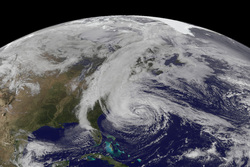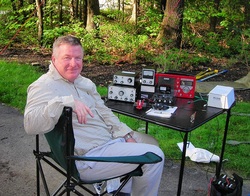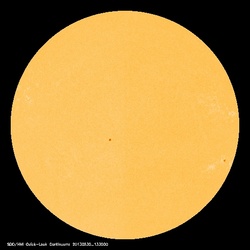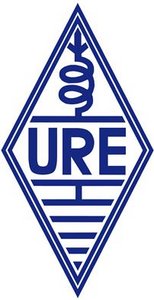 May 30, 2013 John E. Ross, KD8IDJ, Editor
| |||||||||
There will be no ARRL Audio News today, Thursday, May 30. The Audio News will return on Thursday, June 6. Public Service: Forecasters Calling for "Active or Extremely Active" Atlantic Hurricane Season
Forecasters with the National Oceanic and Atmospheric Administration (NOAA) are calling for an "active or extremely active" 2013 Atlantic hurricane season. In its initial outlook for the 2013 Atlantic hurricane season -- which begins Saturday, June 1 and runs through November 30 -- NOAA's Climate Prediction Center is forecasting a 70 percent likelihood of 13-20 named storms (winds of 39 miles per hour or higher), of which 7-11 could become hurricanes (winds of 74 miles per hour or higher), including 3 to 6 major hurricanes (Category 3, 4 or 5 with winds of 111 miles per hour or higher). These ranges are well above the seasonal average of 12 named storms, 6 hurricanes and 3 major hurricanes. Read more. Public Service: Amateur Radio and Hurricanes
Rick Palm, K1CE, editor of the ARRL's ARES E-Letter, warns that now is the time for ARES members to assess their portfolio of communications equipment and disaster response knowledge. Palm gives several tips for radio amateurs who are involved with hurricane operations:
Palm said that during hurricane events, there are usually two or three regional nets (usually on 40 or 20 meters) that are key assets to the disaster response on an ad hoc basis. "Watch for these nets, as well as the nationally recognized networks described above, this season," he advised. "Don't transmit on their frequencies unless you are absolutely sure you have something substantive to add, and then only under the direction of the net control station."
ARRL Emergency Preparedness Manager Mike Corey, KI1U, added that when ARES activates in response to any tropical event, it is crucial that information flows up through the ARRL Section and is reported to ARRL Headquarters. "These reports allow us to develop the situational awareness and disaster intelligence that is required for us as an organization to support the Sections that are impacted." he explained. "In this way, we are able to respond to relevant requests from the media and finally to coordinate with the governmental and non-governmental organizations. This information also allows us to make the decision at Headquarters on whether to activate the ARRL HQ Emergency Response Team to support and coordinate the operations." Corey noted that in July, the ARRL will host a webinar on the 2013 Atlantic hurricane season. Details will be posted on the ARRL website and in the June issue of the ARES E-Letter, as well as here in The ARRL Letter. All those interested in public service and disaster communications are invited to participate. ARRL Comments on Proposed Expansion of 5 GHz Unlicensed Broadband
Observing that "a decision in the near term with respect to the addition of [unlicensed National Information Infrastructure] U-NII devices to the 5.85-5.925 GHz band would be premature," the ARRL has commented in response to an FCC Notice of Proposed Rule Making (ET Docket No. 13-49) that proposes to authorize U-NII use of an additional 195 megahertz of spectrum in the 5.35-5.47 GHz and 5.85-5.925 GHz bands. The Commission was obligated, pursuant to Section 6406(a) of the Middle Class Tax Relief and Job Creation Act of 2012 (Public Law No. 112-96), to begin a proceeding to allow U-NII devices in the 5.35-5.47 GHz band. As the ARRL comments note, "There is no legislative obligation, however, to make available the 5.85-5.925 GHz band for U-NII use." Read more. FCC News: FCC Seeks Small Vanity Call Sign Fee Increase
The FCC released a Notice of Proposed Rulemaking on May 23, seeking to raise the fee for Amateur Radio vanity call signs by 20 cents. Currently, a vanity call sign costs $15 and is good for 10 years; the new fee, if approved, will go up to $15.20 for 10 years. The FCC is authorized by the Communications Act of 1934, as amended, to collect vanity call sign fees to recover the costs associated with that program. The vanity call sign regulatory fee is payable not only when applying for a new vanity call sign, but also upon renewing a vanity call sign for a new term. The ARRL VEC will process license renewals for vanity call sign holders for a modest fee. The service is available to ARRL members and nonmembers, although League members pay less. Routine, non-vanity renewals continue to be free of charge for ARRL members. Trustees of club stations with vanity call signs may renew either via the ULS or through a Club Station Call Sign Administrator, such as the ARRL VEC. Read more. On the Air: June VHF Contest Coming June 8-10
As summer starts to warm up, the VHF bands will be hot for the 2013 ARRL June VHF Contest, June 8-10. Even with a modest station, it's possible to work hundreds of miles on the VHF bands during a good opening. ARRL Contest Branch Manager Sean Kutzko, KX9X, is a VHF enthusiast. "The June VHF Contest occurs at the beginning of summer's sporadic E season, which can produce intense openings on 6 meters, and even 2 meters," he said. "With interesting propagation characteristics like sporadic-E, tropospheric ducting, aurora and even meteor scatter and moonbounce, VHF offers QSO opportunities that HF can never satisfy. The weekend promises to be a tremendous amount of fun on the VHF and UHF bands. Don't miss out! All amateurs -- from Technicians to Extras, experienced VHF operators to the first-time VHF dabblers -- can join in the fun." Read more. Solar Update
Tad Cook, K7RA, reports: The average daily sunspot numbers sank nearly 50 points this week to 94.3, while the average daily solar flux was down more than 16 points to 117.8. The geomagnetic indices were quite high, due to a solar wind storm. The predicted solar flux for the near term is 105 on May 30-June 1, 110 on June 2-5, 120 on June 6, 125 on June 7-8, 130 on June 9, 135 on June 10-11, and rising to 140 for June 12-13. The predicted planetary A index is 5 on May 30-31, 15 on June 1-2, 10 and 8 on June 3-4, 5 on June 5-10, and then 8, 12, 8 and 5 for June 11-14. Look for more information on the ARRL website on Friday, May 31. For more information concerning radio propagation, visit the ARRL Technical Information Service Propagation page. On the Air: Spanish Amateurs Gain New Privileges on 160 Meters
The Unión de Radioaficionados Españoles, Spain's IARU Member Society, has announced that Spanish amateurs may now use 1810-1830 kHz in the 160 meter band on a secondary basis. This is in addition to the existing primary allocation of 1830-1850 kHz. The new 630 meter band -- 472-479 kHz -- is also available to Spanish amateurs now. Both changes took effect on May 10. This Week in Radiosport This week:
Next week:
All dates, unless otherwise stated, are UTC. See the ARRL Contest Branch page, the ARRL Contest Update and the WA7BNM Contest Calendar for more information. Looking for a Special Event station? Be sure to check out the ARRL Special Event Stations web page. Upcoming ARRL Section, State and Division Conventions and Events
To find a convention or hamfest near you, click here. ARRL -- Your One-Stop Resource for Amateur Radio News and Information Join or Renew Today! ARRL membership includes QST, Amateur Radio's most popular and informative journal, delivered to your mailbox each month. Subscribe to NCJ -- the National Contest Journal. Published bi-monthly, features articles by top contesters, letters, hints, statistics, scores, NA Sprint and QSO Parties. Subscribe to QEX -- A Forum for Communications Experimenters. Published bi-monthly, features technical articles, construction projects, columns and other items of interest to radio amateurs and communications professionals. Free of charge to ARRL members: Subscribe to the ARES E-Letter (monthly public service and emergency communications news), the ARRL Contest Update (bi-weekly contest newsletter), Division and Section news alerts -- and much more! Find us on Facebook. Follow us on Twitter. ARRL offers a wide array of products to enhance your enjoyment of Amateur Radio. Donate to the fund of your choice -- support programs not funded by member dues! Click here to advertise in this newsletter (subject to space availability). | |||||||||
















